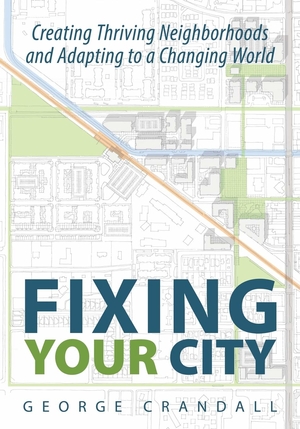Have you ever visited a city only to discover that its downtown area is neglected, difficult to navigate, and devoid of all personality? Have you visited a city that’s the polar opposite and greatly enjoyed the local hangouts, niche shops, good food, and an ease of pedestrian travel? If you’ve ever had these experiences and wondered why the heart of some cities are so welcoming while others are devoid of all cheer, then George Crandall’s Fixing Your City: Creative Thriving Neighborhoods and Adapting to a Changing World may be the book for you.
[alert variation=”alert-info”]Publisher: Crandall Arambula
Formats: Paperback
Purchase: Amazon[/alert]
Fixing Your City suggests ways to do exactly that, but ties it all back to the importance of city planning. Crandall has over forty years of personal experience, and taps into this to clearly lay out the importance in city planning, and how we can change our cities for the better.
“Though it may seem an oversimplification to evaluate a city in terms of its pedestrian experience, the fact is that the public’s yardstick for what constitutes a favorite city is how it feels to walk down the streets of that city. Invariably, desirable places are pedestrian-friendly.”
The book is broken down into multiple easy to consume chunks that lay out the problems facing the massive undertaking of planning a city in the first place, or trying to update an existing city into modern times. Not only does the book point out larger issues like climate changes and over-congestion, but it also takes the time to explain specific terminology that may be unfamiliar to the reader, while fitting these into related segments of the book. Rather than being thrown a ton of vocab in a list, Crandall works your learning into the text of the book itself, which really helps with the accessibility for this work. The book also uses a number of graphs, maps, and infographics to help visualize some of the ideas described within.
The book discusses Portland in particular throughout the book with regards to the issues it has faced over the years including flops and successes. These are interesting bits of history that locals as well as visitors to the city may find fascinating and help ground the larger ideas and concepts that are presented in the title to have a more tangible and concrete examples. While Fixing Your City is likely a niche interest title, it’s informative, accessible to the layman, well structured, and a wonderful resource for anyone interested in the topic of urban planning.
[signoff predefined=”Sponsored Review Program” icon=”book”][/signoff]

